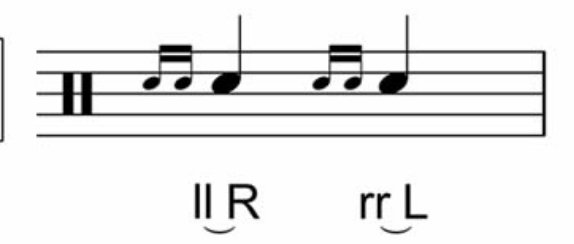DRAG RUDIMENTS
Drag
The Drag is the last big pillar of rudiments you'll need to learn. Simply put, it's a double followed by a single. The key, like a flam, is the spacing/timing between these two figures, so watch the video below to get an idea of how it sounds. This rudiment can also be played with both hands leading, so make sure to practice with the R and L lead. Spend a good amount of time with the drag, mastering how it feels, and getting a clean double/tap as it is the basis of all the rudiments to come in this section. It's very commonly put into beats and fills, adding a subtle flare, that gives your playing another level of maturity.
Single Drag Tap
The Single Drag Tap is just as the name sounds, you'll play one drag followed by a tap on the opposite hand. Like all the flam rudiments, it can be tricky to remember which hand was the drag and which hand was the main note. Spend time practicing this slowly to keep track, as the correct sticking is everything!
Double Drag Tap
The Double Drag Tap adds onto the single drag tap: You'll drag 2 times and then tap the opposite hand. This is a three note grouping and gives a great jazz/swing feel because of the drags. Focus on getting really clean drags since you now have 2 in a row.
Lesson 25
The Lesson 25 rudiment gets its name from the original 26 rudiments (which were expanded into the 40 you are learning now) given it was the 25th in the series. To play this rudiment, you'll first start out with a group of three notes, putting an accent on the end. Once you feel comfortable with this, add in a drag to the beginning. Make sure to get a clean drag at the beginning and accent at the end.
Single Dragadiddle
The Single Dragadiddle is another expansion on your fundamental paradiddle. This rudiment is unique in that instead of adding a drag onto the beggining of the pattern, the drag becomes the first note instead. This gives a really cool double to what was a single, and is a great rudiment to master for adding into fills.
Drag Paradiddle #1
The Drag Paradiddle #1 Is the last set of expanded paradiddle's. You'll start with an accent, and then drag into your paradiddle. Be aware you need to drag into the paradiddle, and note replace the first note with a drag, like the dragadiddle. Since this is one of the more complexe paradiddle combinations, be conscious to make sure you get the actual paradiddle pattern at the end, as it's easy to overlook being so focused on the accent and drag.
Drag Paradiddle #2
The Drag Paradiddle #2 is just like the previous rudiment, but adding 2 drags instead of 1. Practice this along side the #1 pattern, making sure to feel the difference between these two rudiments. As always, focus on clean accents, drags, and accuracy of the paradiddle.
Single Ratamacue
The Single Ratamacue is the first in the final set of drag rudiments. It's based on a single stroke four roll, adding a drag onto the beginning and an accent to the end. Because this rudiment is so short and switches leads so quickly, go slowly and carefully to make sure you stay accurate.
Double Ratamacue
The Double Ratamacue builds on the previous rudiment and uses 2 drags. When adding multiple drags in a row it's easy to play them slightly less clean, so be make sure both the double and the single of the drag are defined.
Triple Ratamacue
The Triple Ratamacue builds on the is the last in the ratamacue series, and like the name, adds a 3rd drag onto the front end of the pattern. Like the previous two rudiments, spend time getting very clean drags and an accent at the end of the pattern.










